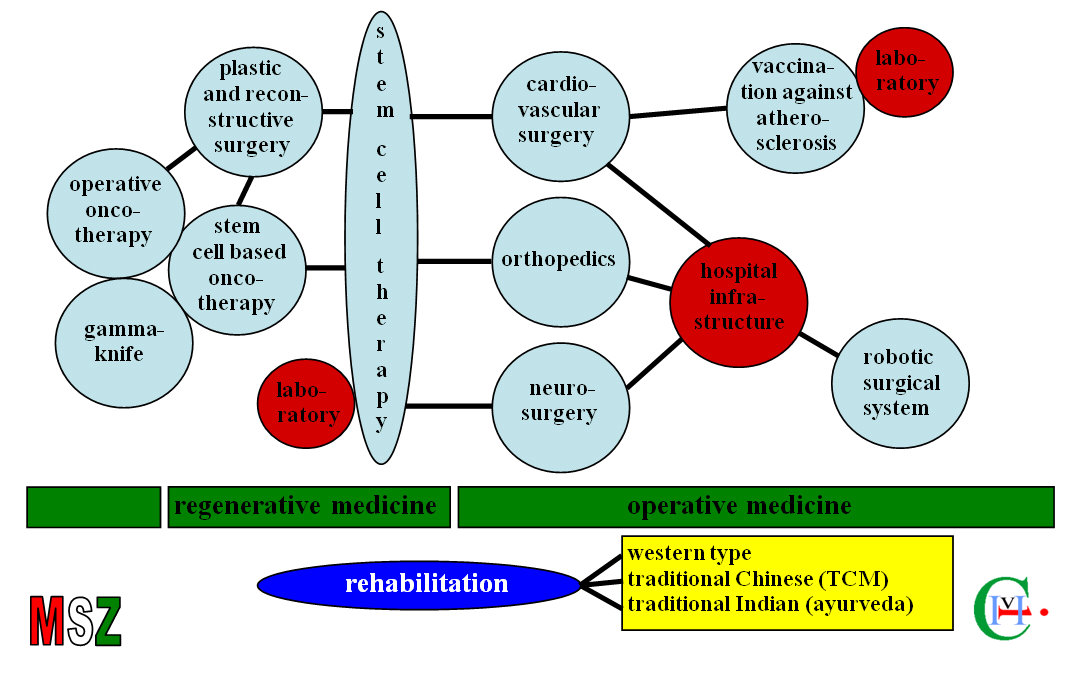Medical City of Hungary — Phase #1
(1.) Overall view
The Medical City of Hungary is planned to be established within the European Union in Hungary in order to serve the continuously growing demand of people for medical tourism, at the highest European level of quality.
Hungary is a full-right member of the European Union since 2004 and the NATO since 1999. Hungary is located in the very middle of Europe, close to both the western part and eastern part (Ukraine, Russia) of it. Hungary is famous for its education, medicine, research, and the high number of Nobel-prized scientists of Hungarian origin. Hungary has been appointed to be the host country of the research and innovation center of the European Union, the European Institute of Innovation and Technology in 2008.
The Medical City of Hungary is intended to be placed into a very nice forest-surrounded plain field of 2 million square meters in the close vicinity (15-minute-drive far) of the Budapest Ferihegy International Airport, next to the M0 beltway which runs around the capital city Budapest and connects M1, M2, M3, M5, M6 and M7 highways to each other. Nevertheless, the area for the medical city is out of each noise zone of the Airport, as well as the noise zones of the motorways.
The Medical City of Hungary would incorporate today’s best-practise medicine, research and development, education and include e.g. robotic surgery, intelligent prosthetic devices, stem cell therapy, vaccination against atherosclerosis, gamma-knife radiosurgery and space research tasks. In addition, the inclusion of Hungary’s unique thermal baths and wellness centers into the Medical City project could enable the country to become the “medical capital of Europe” and a center for international medical tourism.
(2.) Idea and gist of the Medical City of Hungary
The major idea and the gist of the Medical City of Hungary is the unique combination of today’s best-practise operative medicine with the stem cell based regenerative medicine in the fields of (i) cardio-vascular surgery, (ii) neurosurgery, and (iii) orthopedics. Operative medicine will comprise e.g. the ‘da Vinci robotic surgical system’, Leksell PERFEXION gamma-knife, state of the art diagnostic equipment, while regenerative medicine will be based on the utilization of both autologous (bone marrow, peripheral blood, rejuvenilated connective tissue) and allologous (umbilical cord, umbilical cord blood, amniotic membrane) adult stem cells for regenerating heart muscle, blood vessels, neurons, glial cells, bone and cartilage.
Furthermore, besides the traditional onco-therapy methods (surgery, chemotherapy, radiotherapy, gamma-knife), a brand new stem cell based cellular technique on onco-therapy will be also performed in the Medical City of Hungary.
The minor idea and speciality / 1. of the Medical City of Hungary focuses on the rehabilitation: western-type rehabilitation methods will be combined with the techniques of the traditional Chinese medicine (TCM) and Indian medicine (ayurveda).
The minor idea and speciality / 2. is based on the application of a unique Hungarian invention, an active immunization (vaccination) against atherosclerosis which can cure the atherosclerotic individuals.
(3.) Structure of the Medical City of Hungary
As phase #1, the Medical City of Hungary will comprise:
— today’s best-practise and best-equipped western-type multiprofile hospital of 300 beds (cardio-vascular surgery, neurosurgery, orthopedics);
— the European ’Beike Stem Cell Treatment Center’ (heart muscle, blood vessels, neurons, glial cells, bone and cartilage);
— a stem cell based onco-therapy center;
— a western-type multiprofile rehabilitation center;
— a traditional Chinese medicine (TCM) center;
— a traditional Indian (ayurveda) medicine center;
— a gamma-knife radiotherapy center;
— a ’da Vinci robotic surgical system’;
— a vaccination center against atherosclerosis;
— laboratories and research centers;
— hotel facilities of 600 beds;
— a congress center for 1000 people.
(4.) Cost of the investment of the Medical City of Hungary
The phase #1 of the Medical City of Hungary costs 260 million US dollar. This expense comprises the cost of the area where the Medical City will be placed; the costs of the establishment of the public utilities and inner road-system; the costs of the development of the main hospital building, western-type multiprofile rehabilitation center, traditional Chinese medicine (TCM) center, traditional Indian medicine (ayurveda) center, laboratories, hotel buildings; and finally, the costs of equipment for rehabilitation, general medical equipment and equipment of great value, i.e. Leksell Gamma Knife, 3.0 tesla MRI scanner, 64 slice CT scanner and ‘da Vinci robotic surgical system’.
(5.) Coherency of the Medical City of Hungary

(6.) Planned research tasks in the Medical City of Hungary
Medical City of Hungary will perform research tasks in the fields of:
— robotic surgery;
— 3-dimensional movement analyser and planner systems;
— neuron-based computers;
— infobionics;
— artificial retina, artificial eye;
— artificial synapse;
— modelling of normal and pathological human physiological processes;
— softwares for analysis of human speech and behaviour;
— space research developments;
— robotics;
— security softwares;
— intelligent prosthetic devices (e.g. artificial touch-sensing and gripping device);
— telecommunication.
Budapest, Hungary, 2010